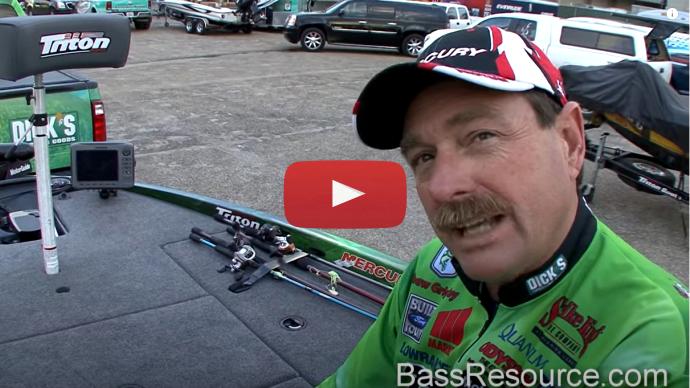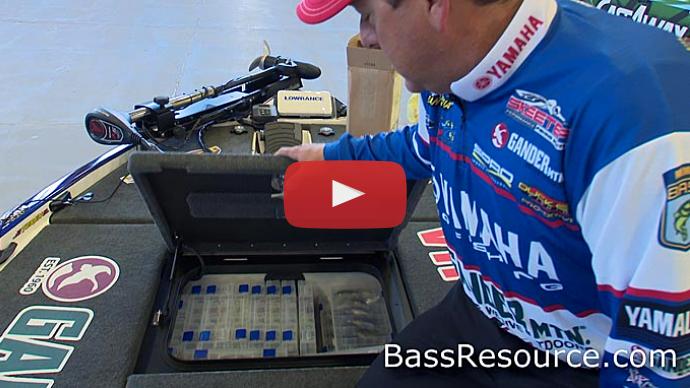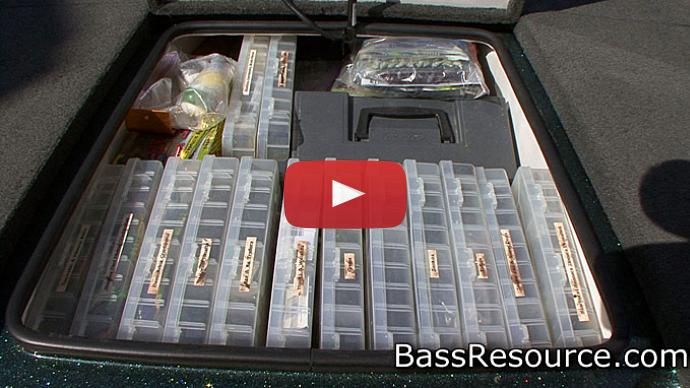All right. Hey, folks, how are you doing? I am Mike Iaconelli. I am here at the Bassmaster Classic in New Orleans. I want to take you around my boat, take a tour of my boat, all right?
We will start up here on the front deck. Come on, let's go!
All right, key stuff right here--obviously, electronics, super-important to what we do--deep-water, shallow-water, it does not matter. We need to have quality electronics, so I have the Lowrance--the big ones, the 10s--and I have put the big unit on a big heavy-duty RAM mount.
Now, this is the kind of RAM mount that rough water will not mess up, but it lets met adjust it to whatever the sun conditions are. It really lets me get a look at that screen, so that is my big one. Then if you look a little further, you see that I have a smaller one. I will pop this off for you here. I have a 5--HDS 5--and what this is here for is backup, because as good as these Lowrances units are, stuff happens. Every once in a while, something is going to happen. If this one goes down and I get in trouble--I still need GPS, I still need depth--I just turn on my spare, and I am ready to go.
Okay. Let's keep going. We have the trolling motor, another super-important piece of equipment, a Minn Kota 101 36-volt. It pulls this boat along great. I have it rigged. It is a pretty neat deal, here, instead of having it hardwired--never hardwire your motor--always rig it with a three or four-prong adaptor. Then, I carry a spare with me, so if this motor goes down, if something happens, all I have to do is go get my spare, pull it out, get the other one, plug it back in and I am ready to go, so put your trolling motors on these plugs.
Here is a really neat one for you. I just told you about all this really expensive stuff. Let me show you something that is inexpensive that is probably more important than any of this stuff I just talked about. It is a darned marker buoy. The thing costs about two dollars. Go to Dick's Sporting Goods. You can buy about five of them for ten bucks. I am going to tell you, these marker buoys are super-important, whether you are shallow-water or deep-water, it does not matter. If you see something out of the ordinary, if you catch a fish and you want to mark it, the best way to do it is with an old-fashioned marker buoy, so I keep one with me in the back, I keep one in the front, and I just use a little bungee strap and I put that thing in there, and I always have it ready to go.
Okay. Let's keep looking. Let's head to the back here a little bit and we will look at some of these hatches. You know, the nice thing about this Bass Cat is the layout. It is one of the things I love about this boat. This is a Puma FTD, by Bass Cat. Check out the storage on this boat. We have two front hatches, and in these hatches, I basically put all my hard baits, and I separate them by style, so on the left side, I have all my top-waters: my vibration baits, my shallow crankbaits, my jerkbaits. Then on my right side, I have my deeper-diving crankbaits: my medium baits, deep, and then super-deep crankbaits on this side. Everything is organized by style. Everything is organized by color. It is really big and roomy so I can carry lots of stuff with me, especially in practice. I want to carry lots of stuff with me so I can change on the fly.
Now you have two rod lockers in this boat. I use the right-side locker for more tackle. I am going to put my jigs in there and my spinner baits. I am going to put some swim baits in there. I am going to kind of load this up with more tackle. Then we have our left-side rod locker, and this is where all my rods are going to go. Believe it or not, when I am practicing for a tournament, I keep up to 30 rods in this thing. Take a little peek at how big that thing is. I will separate them: I will use those rod separators, and I will also use those rod socks to keep the rods from getting tangled up together.
All right, let's keep going. Let's go a little bit down here. We have a couple of smaller hatches. We have one. We have our cooler. We have all our food, our drinks, and we can put our ice in here. We have a smaller hatch here, and in here, I am going to put things like culling equipment, I am going to put things like dyes, pens and glue, and then I am also going to put some scent in this thing. This is stuff that you need everyday, and I want to have easy access to it, at my fingertips.
The next thing we have down here--this is a cool little deal, this little thing. It is kind of like a little pencil holder. It is a great spot to put all your tools, you know, so I have kept the basics. I carry a Phillips' head, a regular screwdriver, a scissors, a nips, a pair of pliers, and, last but not least, a hook file, and they all stay nice and tight in here. This is all stuff that gets used every single day--it is all my tools, okay?
All right, we are almost done, getting back here to the console. The console layout is pretty much the same as the front. I have my big Lowrance unit: my HDS 10. I have an HDS 5 in-dash in case something happens to the 10, and then I have my little tricks of the trade here. One is a hydraulic jack plate. You know, for guys that fish shallow water--you are power-fishing, you like fishing shallow--you have to have that hydraulic plate. It is super-important. I put it on the turn-signal style switch.
Then, another really important piece of equipment--I know everybody has heard about it out there--is called a PowerPole. If you do any kind of shallow-water fishing, if you flip, if you pitch or if you like to sight-fish, you have to have a PowerPole. I mount it with two toggles, one on the front and one right here on the console, and just with the push of a button, I can raise or lower that PowerPole to keep me in position.
One last little thing--and this is just kind of for me when I want to make myself happy--I have an iPod holder right here. This is from Lowrance. You can pop your iPod straight in there. We have our speakers, we have our woofers, we have some tweeters built up in here, and--hey, you know what-- if the fishing is bad and you want to rock out a little bit, put in your favorite tunes. Put in whatever you like to listen to.
Okay. We are almost done. Getting to the back, we have two smaller hatches in the back. We have one hatch that is going to be for all our tools--our straps, our rope, our heavy-duty tools in case something needs to happen, a first-aid kit--so the basic necessities in that one. Then, in the last hatch, we are going to put all our terminal tackle in smaller boxes. For example, here are my weights. Pop it open. I have all my tungsten weights from one-sixteenth of an ounce all the way up to two ounces, all organized by size. Jigheads, tubes, dropshot weights--any kind of terminal tackle goes in this hatch.
Okay, finally, let's get to the back here. Oh, wait a minute! Did I tell you that I also have a UFO in my boat? This thing looks kind of goofy, but this is a Lowrance radar unit. For a tournament like this where we are making long runs--we have possible fog conditions--this is a really awesome tool, you know? Most guys who use this are saltwater guys, but in a situation like the Classic, I want to have every tool I can to help me get to my spot, so we have our radar mounted, and then finally, our battery box. Come on back here. In the battery box, we have four Trojans, 32-style batteries. We have our battery chargers--we have a four-bank battery charger--and we have our cable to plug in.
Well, I think we have pretty much hit it all. Bass Cat Puma, Yamaha outboard, PowerPole, Minn Kota trolling motor, and, of course, Lowrance electronics. That is my boat. Now get out of here, I have tackle to do!




